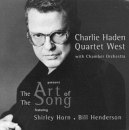


Sting
Brand New Day
***1/2
Six years after the release of his strongest solo effort, Ten Summoner's Tales, Sting has returned with Brand New Day, an album that mixes slow jazz with infectious pop and a healthy dose of international flavors. To be sure, Day finds the former Police frontman wandering farther than ever from the musical territory charted by his old band, but perhaps that's not such a bad thing. After all, the artist formerly known as Gordon Sumner is now 48, and it has been 13 years since he last reunited with former bandmates Stewart Copeland and Andy Summers. During that time, Sting has staunchly refused to look back. Every so often, he pops up on the Billboard charts, but Sting is hardly the singles machine that the Police once were.
That much is evident on Brand New Day. The album begins on a high note with "A Thousand Years," an ode to unrequited love that moves slowly and seductively toward its moving chorus ("I still love you/I still want you/A thousand times these mysteries unfold themselves/Like galaxies in my head/On and on the mysteries unwind themselves/Eternities still unsaid/'Til you love me"). With its hypnotic rhythms and its haunting guitar riffs, "Years" is the most powerful track on the album, carrying the same emotional impact as earlier hits like "Fortress Around Your Heart." Meanwhile, "After the Rain Has Fallen" is irresistible, straightforward pop that, with its catchy chorus and pleading vocals, recalls past singles like "If I Ever Lose My Faith in You" and "All This Time."
While the rest of Brand New Day is consistently strong, Sting struggles to maintain the momentum generated by these opening tracks for the length of an entire album. "Perfect LoveŠ Gone Wrong" comes off as silly and misguided; "Fill Her Up" degenerates too quickly into the uncharacteristically bland, directionless jazz that permeates the album.
Still, there are plenty reasons to recommend Brand New Day. "Tomorrow We'll See," written from the perspective of downtrodden prostitute ("My skirt's too short/My tights have run/These new heels are killing me"), is an appropriately somber response to "Roxanne." Meanwhile, the final tracks on the album ‹ "Ghost Story" and "Brand New Day" ‹ are two epics that emphasize Sting's diverse talents as a songwriter. "Ghost Story" is a slow, soothing meditation about love and aging that draws in listeners with its hypnotic rhythms and refuses to let them go until the bitter end; "Brand New Day," however, is a much more optimistic track, contemplating the pros and cons of romance in the context of yet another uptempo, infectious pop song.
While a Police reunion is unlikely, fans can take comfort from the fact that Sting continues to produce vital, comlex and undeniably appealing music on his own. And though Brand New Day may not be his strongest effort to date, it is nevertheless a powerful testament to his status as a true pop icon.
-Rossiter Drake

Charlie Haden with Quartet West
The Art of the Song
* * *
Forty years after taking the jazz world by storm with the legendary Ornette Coleman Quartet, bassist/composer Charlie Haden continues to produce new music and explore a personal approach to improvised playing. For the past six years, Haden has turned to increasingly lyrical projects, most notably in duo settings. In 1994 Haden teamed up with pianist Hank Jones on Steal Away ; 1997 brought Haden together with folk guitarist Pat Metheny on Beyond the Missouri Sky; in 1998 pianist Kenny Barron joined Haden for an album of jazz standards called The Night and the City. These albums all show an increased attention to tender melodic developments and a deep nostalgia for simple themes.
Charlie Haden's newest album, The Art of the Song, simply doesn't compare. His passion for introspective, sensitive playing has led him and his rather sterile Quartet West into a world of Hollywood-style incidental background music, all accompanied by full chamber orchestra. Included are four tracks each with singers Shirley Horn and Bill Henderson.
Shirley Horn is in fact one of the main saving graces on this album ‹ her long standing reputation for milking jazz ballads serves her well here, especially on the introductory "Lonely Town" and her rendition of Bing Crosby's "The Folks Who Live on the Hill." Her powerful, sometimes mournful voice and attention to phrasing is a fitting partner for Haden's bass playing, and is strong enough to transcend the orchestra and saxophonist Ernie Watts' personal batch of West Coast easy listening jazz.
Bill Henderson, the other featured vocalist, does more to detract from the playing and arrangements, which are all done by Quartet West pianist Alan Broadbent, than to add to them. His harsh, choppy style and questionable intonation displaces him from the smoothness of his musical surroundings. In the liner notes, he was hailed as sounding like "a cross between a matinee idol and a pixie." Unfortunately this vague label does nothing to describe Broadbent's playing except to confuse the listener.
There are some very powerful musical moments on the album ‹ most notably Broadbent's adaptation of Rachmaninov's "Moment musical opus 16 no. 3 in B minor," for bass, sax, and orchestra, which has one of only two featured bass cameos. Also, the album closes with a haunting rendition of the folk/gospel anthem "Wayfaring Stranger," with string quartet and Charlie Haden on vocals, his first recording since his vocal chords were paralyzed by polio at age 15. His peculiar, half spoken, wistful voice combined with intelligent arranging make for an unexpected powerful postlude.
The Art of the Song, may not be Charlie Haden's strongest work to date, but is definitely worth listening to. The best bet might be going to Mudd and burning a copy.
-Zack Hickman
Stereolab
Cobra and Phases Group Play Voltage in the Milky Night
* * 1/2
Certainly not a conclusion, but an underlying presumption arrived in my mind as I contemplated purchasing th Co-Op's remaining copy of Stereolab's Cobra and Phases Group Play Voltage in the Milky Night.
Laetitia Sadier and her mostly French and English comrades were making significant contributions to the genre of electronic pop early this decade, and this was before Madonna's Ray of Light tried to bring it to the masses. I believe this was still before famous TIMARA geeks Tortoise and Trans-Am were brave enough to hit the 'Sco.
Esteemed engineer/producer John McEntire has lent his masterful hand to Stereolab's latest two releases. Yet while proven talent can be a surer indicator of success, creativity and urgeful ingenuity still seperates a good record from a great record.
Pop artists have always had obvious tendencies toward over-accessability, and Stereolab's previous Dots and Loops (1997) shows that they have been no exception to this ailment. Spend the required 75-minutes with Cobra and PhasesŠ and you'll hear a familiar pattern. The melodies are nice and the soundscapes and progressions are mildly compelling. The never-ending repitions will urge you to make it background music for your next Lit Theory paper, Phillips Gym routine, or afternoon bong hit‹ whatever your preference may be. This time over, the scattered Moog improv and endless repetition comes across as tiresome and lackluster.
Stereolab really seemed to have found their voice when they played Finney Chapel in 1996. This was after their astonishing first major-label release Emperor Tomato Ketchup (Elektra), by far their most mainstream release. Buy this record instead. History may repeat itself insofar as the gradual de-alternifying of rock genres. This is what happened to "alternative" music in the early part of the decade. This fate will very much plague "indie" rock as well. Electronica seems to be following this pattern.
The reality is that as talented artists become progressively more widely received, they reach a point where creativity becomes endangered by what the record label wants the band to sound like. This could be avoided if Pavement was left by themselves to cut a good record and Yo La Tengo was able to create their distinctive brand of song that raises goosebumps.
Stereolab has made a departure from their status as trend-setter. Nothing really new, but who's complaining?
‹Zach Fried Ś99
Copyright © 1999, The Oberlin Review.
Volume 128, Number 7, October 29, 1999
Contact us with your comments and suggestions.